View south-west of Mill Hill from the edge of the ridge below the upper car park
View south-west of Mill Hill from the edge of the ridge below the upper car park
| OVERVIEW:
The original historic reports state that originally 70 acres of Mill Hill were presented to the people of Shoreham in 1938. Just over 30 acres still remain as public open land. This is divided into about 11 acres of grassland and meadows above the ridge, about 9 acres of scrub, the copse and glades at the northern end, and about half of the prime Chalkhill Blue area of 6.4 acres of herbland remaining. 6 acres has been lost to a Sycamore woodland on the southern slopes. This is low fertility chalkland not suitable for grazing. The top area is effectively a wild meadow and the lower slopes a rabbit warren dominated by prostrate (not the upright form) Horseshoe Vetch. |
|
||||
| Chalkhill Blues:
Mill
Hill is nationally important because of its population of Chalkhill
Blue Butterflies. Estimates of the numbers
are notoriously inaccurate. In the 1950s the population was estimated by
R. M. Craske to be 50,000. This may be an
exceptionally good year. I would estimate the numbers at that time to be
nearer 25,000 for Mill Hill only. After the cattle grazing and thorn incursions
the
numbers plummeted to the most reliable estimate in 1960 of 6,000. The new
road and Sycamore woodland further denuded the Horseshoe
Vetch and bare chalk downland to a figure
I have estimated at a top figure of 3,000 Chalkhill Blue Butterflies at
the turn of the millennium (counted in 2003). Almost all these butterflies
are now to be found on the six acres of the lower slopes.
Text
by Andy Horton
|

 |
Link to the Mill Hill Wildlife Reports 2006
14
December 2005
Nothing
of note was seen on the lower slopes or the upper plateau of Mill Hill
on a warm (air 9.8° C wind chill 7.9°
C) afternoon for December.
There were no flowers of any kind noticed, no fungi
and only the common birds with over fifty Rooks
shared the field with a herd of cattle, east of and uphill from Old Erringham
Farm. Yellow Xanthoria lichens
covered
the south-facing branches of the bare
Hawthorn
bushes now devoid of berries, and the Beech
leaves on the diminutive trees turned a golden brown.
22
November 2005
A
small sparrow-sized dark brown bird perched on the top of a bare Hawthorn
bush south of the Reservoir and next to the country road. I am not familiar
with a rather richly plumaged bird with a white neck loop. It could have
been a Tree Sparrow.
The bird could not be approached and readily flew to another bush as I
tried to get close for a better look through my binoculars.
In
the east (New Erringham pasture), cattle grazed the field of grass and
diminutive Ragwort,
where about eight Rooks
foraged. A Kestrel
hovered and flew at low level like a Sparrowhawk.
Blackbirds
were seen at at least twice and there certainly more of them.
A
few remaining flowers included Yarrow,
Hardheads
and
Hawkweeds
only, apart from the straggly remains of the Clematis
that adorned the scrubbery.
In
the Triangle area (middle slopes) there were
over a dozen small mushrooms called the Pale
Wax Cap, Hygrocybe berkeleyi, (known on the British
Mycological List as Hygrocybe pratensis var pallida)
near the seat.
Shoreham
Fungi 2005
Adur
Hygrocybe
16
& 22 November 2005
A
flock of Sheep were now seen on the
agricultural pasture of Old Erringham on the Adur
Levels below the meadow (see below).
9 November
2005
A
flock of Sheep
were grazing on the agricultural meadow below (to the west of) Mill
Hill Nature Reserve seen from the A27.
6 November
2005
The
tall mushroom Volvariella
gloiocephala
grew on the edge of the
meadow north of the car park on Mill Hill. Its gills were light brown.
There
was little of interest, a probable Skylark
hanging in the breeze and a small flock of about five Pied
Wagtails were noted. I made a brief wander
around the plateau and copse at the top
and did not bother with the lower slopes.
Shoreham
Fungi 2005
23
October 2005
With
the flowers diminishing the flying insects were hardly recorded with just
one
Red Admiral Butterfly
recorded and no dragonflies. Plants noted still
with the occasional flower included Hawkweeds,
Greater
Knapweed, Hardheads (Lesser Knapweed), Red Star Thistle (a knapweed), Yellow
Wort (one plant noted still with flowers on
the lower slopes), one Red
Clover (on the middle slopes), Devil's
Bit Scabious (cut back by a gardener on the
lower slopes), just one Bramble
flower and a few flowering plants of Yarrow.
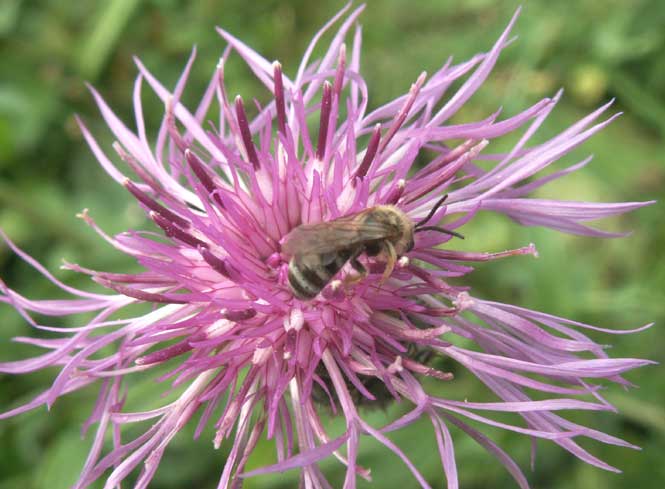 |
 |
|
|
Greater
Knapweed visited by a Yellow-footed
|
Solitary Bee, Lasioglossum xanthopum. |
|
Scabious
are hard to separate to species. The taller Field
Scabious, Knautia arvensis, was no
longer in flower, so I think it is the Small
Scabious,
Scabiosa columbaria,
that is in flower with a few isolated flowers noted on the flat plateau
turf north of the Reservoir.
There
were a handful of mushrooms.
Shoreham
Fungi 2005
Conservation workers had cleared an area of thorn south of the car park. This is not where the urgent work needs to be done to clear the Privet.
17
October 2005
Unmistakable
in its bright yellow with a black outline, only my second Clouded
Yellow Butterfly seen this year fluttered
rapidly over the lower slopes of Mill
Hill. It flew mostly in a southerly direction. Two Red
Admiral Butterflies were recorded south
of the Reservoir on Mill Hill. (The upper
part of Mill Hill was not visited.) Common
Wasps were frequent around the Ivy (near
the stile in the north-west corner) much
more than in the previous years this century.
Butterfly
List for the Day
A
Yellow-footed
Solitary Bee*, Lasioglossum
xanthopum, visited a Stemless
Thistle, one of very few plants remaining
in flower. (* ID
not confirmed of this Nationally
Scarce species, but likely). This was a large Lasioglossum bee.
Adur
Solitary Bees
Status
Definitions And Criteria For Invertebrates
7 October
2005
Even
on the lower slopes (the only area visited)
most of the butterflies had disappeared and
the only ones recorded on Mill Hill (north of the bridge) were two Red
Admirals, two Meadow
Browns,
one female Brown Argus
and one male Common Blue.
Adur
Butterfly & Large Moth List 2005
Berries
were noticed, the harvestable Blackberries
and Elderberries
were still numerous and the black berries of the Privet
and Dogwood and the red hips of Dog
Rose. Returning
by the ridge path, I noticed a dozen or more clumps of Bittersweet
in
a cleared area with berries of dark green, orange-yellow and red. This
is a common wasteland shrub and the berries are mildly poisonous.
14
September 2005
 The
first Clouded Yellow Butterfly
of the year fluttered rapidly in the Moderate Breeze
over Mill Hill just north of the Reservoir, landing in a patch of taller
herbs on the wind-blown plateau. The smaller size and distinct black edging
differentiated this butterfly instantly from the Brimstone.
Apart from a couple of Large Whites
in Shoreham town, they seemed to be the
only butterflies around. However, I only
visited this allotment patch sized plot on Mill Hill and arrived and returned
by road.
The
first Clouded Yellow Butterfly
of the year fluttered rapidly in the Moderate Breeze
over Mill Hill just north of the Reservoir, landing in a patch of taller
herbs on the wind-blown plateau. The smaller size and distinct black edging
differentiated this butterfly instantly from the Brimstone.
Apart from a couple of Large Whites
in Shoreham town, they seemed to be the
only butterflies around. However, I only
visited this allotment patch sized plot on Mill Hill and arrived and returned
by road.
Plants
in flower noted were Autumn Gentian
because of their large (several hundred) numbers in the shorter grass meadows,
Common
Toadflax on the path edges and road verges,
the white flowers of Yarrow,
yellow Hawkweeds
(easy
to confuse with other plants) and the dimunitive
parasitic Eyebright.
The
small beetle Galeruca
tanaceti crawled over the herbs, grass and rabbit droppings
just north of the Reservoir, Mill Hill.
Adur
Beetles
 |
13
September 2005
I am not surprised that I missed the Autumn Lady's Tresses, Spiranthes spiralis, on previous visits as this orchid is very much smaller than expected and already past its best. There were three plants seen in the short grass just north of the Reservoir on Mill Hill. Butterflies included Adonis Blues and Small Heaths but Meadow Browns were the most prevalent. |
12
September 2005
Over
a hundred House Martin's
flew from west to east over Mill Hill in 15 minutes. There were scores
before this as well.
11
September 2005
Autumn
Lady's Tresses are flowering near the
Reservoir on Mill Hill.
 |
The Red Star Thistle, Centaurea calcitrapa, is recorded on the verges of the steps leading down to the lower slopes of Mill Hill. |
| The upper meadows of Mill Hill were full of hundreds of Crane-flies but not a single butterfly was noted in a fleeting passage visit. The Crane-flies were identified by Dr Dave Skingsley (Staffordshire Universities) from the photograph as Tipula sp., possibly Tipula paludosa or Tipula olaracea or as I the wings cannot be seen clearly it might be Tipula vernalis. | 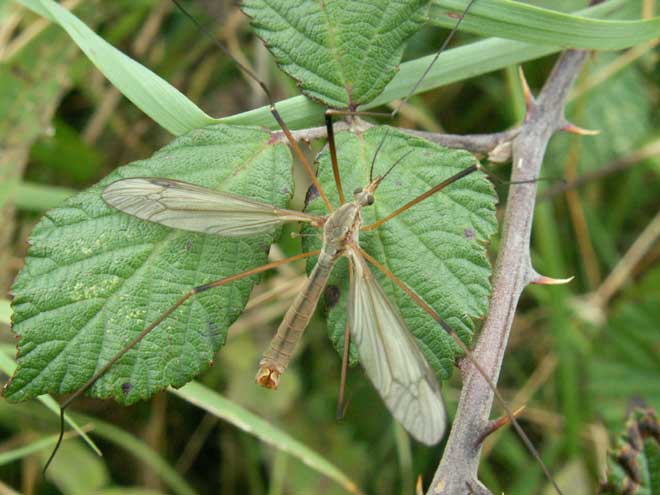 |
30
August 2005
A
clear blue sky without as much as a single white fluffy cirrus cloud and
the day got warmer and by the late afternoon the shade air temperature
was 26.3 ºC.
Scores
of House Martins
flew from west to east over Mill Hill, noticed as I followed the ridge
from a visit to the lower slopes.
21
August 2005
Worn
and battered Chalkhill Blue
Butterflies were
down to a count of about 62, but I was not looking very carefully, Common
Blues
on the lower slopes were past their best
as well and I estimated these at between 65 to 75, with
the first of the second brood male Adonis
Blues confirmed when one these flighty
butterflies settled and some were pristine and some just new .There
were at least ten and possibly twenty.
I returned
via the ridge with a Speckled Wood Butterfly
seen in the Hawthorn.
Butterfly
List for the Day
In
the pasture (New Erringham) immediately to the east of Mill Hill at least
one female Pheasant
ran into the cover of the mixed Ragwort
and longer grass.
16
August 2005
I
counted up to 200 Chalkhill Blue
Butterflies on
the lower slopesof
Mill Hill before I gave up counting. The total
for the day actually seen was about 250 (middle and upper slopes 30, Pixie
Path/Mill Hill Cutting SW 20). There were about 20% females and again
some of these may have been missed. These numbers are fairly good for the
middle of August
when the numbers of Chalkhill Blues
can fall off a bit. Many of both the males and females were worn and some
were showing signs of damage. They are in mating mood and four males could
be seen chasing one female above the short herbs on a handful of occasions,
but usually each of the brown females received the attention of one to
three males.
Chalkhill
Blues were the most numerous butterfly on
the lower slopes, but on the whole of Mill Hill, it was the Common
Blue Butterflies that were the most numerous
and as I returned over the upper meadows, their totals must be upwards
of 300 actually seen (upper meadows on Mill Hill 250, lower slopes 25,
Pixie Path 20, urban fringes 5). Common Blues
were courting as well, with their paired vertical ascendant courtship flights
and mutual attraction amongst the bramble shrub (like the Chalkhill
Blues).
Gatekeeper
Butterflies were few, only two definites,
one on the path by the Wayfaring Bush
leading down to the lower slopes of Mill Hill and one on the scrub on the
middle slopes. Meadow Browns
were very frequently seen but not so numerous as a week ago on the
lower slopes and upper meadows about equally. Small
Heath Butterflies had reappeared on the
lower slopes with at least a dozen observed and a handful more seen above
the ridge. A yellow butterfly was not identified at first over the lower
slopes and then another Brimstone Butterfly
flew into a thistle-covered gap in the Hawthorn scrub in the north-west.
Two pristine Green-veined White Butterflies
greeted
me in this scrub and flew away and landed on Hemp
Agrimony and Perforate
St. John's Wort. In the shade of hedges at
the top of the Pixie Path and in the Hawthorn in the north-west of Mill
Hill,
Speckled Wood  Butterflies
were frequent and Red Admirals
occasional. A handful of Brown Argus
Butterflies were confirmed with a positive
identification from their spots and markings on the upper meadows only
of Mill Hill. There were female Common Blues
as well.
Butterflies
were frequent and Red Admirals
occasional. A handful of Brown Argus
Butterflies were confirmed with a positive
identification from their spots and markings on the upper meadows only
of Mill Hill. There were female Common Blues
as well.
Large
Whites and Holly
Blues were present, the latter near the
hedge bordering the road between the bridge and the southern car park.
Butterfly
List for the Day
A Southern Hawker Dragonfly patrolled the copse at the top of Mill Hill.
7 August
2005
Common
Blue Butterflies were out in large numbers
in the meadows on Mill Hill. In their most prevalent, there was at least
two for every square metre, and I have estimated them at a level of about
one every five square metres over an area of three acres giving an estimated
population of 2400 (this may be hopelessly underestimated?). For every
twenty blues
on the tall herb meadows on the top of Mill Hill, about one was a Chalkhill
Blue. The count for Chalkhill
Blues on Mill Hill was 155 (= an estimated
550) where 13 species (out of 16 for the day) were seen. One Wall
Brown Butterfly was spotted on the ridge
path just north of the Reservoir.
Butterfly
List for the Day
 |
 |
 |
A Common
Field Grasshopper, Chorthippus brunneus,
(first left, above) was observed making a
jump of two metres on the short sward exposed slopes north of the Reservoir.
The long grass usually hosts the green (green on Mill Hill) Meadow
Grasshopper,
Chorthippus parallelus.
Adur
Grasshoppers
A beetle
larva of Drilus flavescens was
seen on the path in the north-west of Mill
Hill.
Invertebrates
from the North-west Hawthorn scrub/wood
2 August
2005
 Chalkhill
Blue Butterflies came out with the sun
on Mill Hill, mostly on the lower slopes. The count of 268
was disappointing for their peak period. They
still represented more than half of the butterflies of fifteen species
seen on Mill Hill (excluding the Waterworks
Road and Slonk Hill south).
Chalkhill
Blue Butterflies came out with the sun
on Mill Hill, mostly on the lower slopes. The count of 268
was disappointing for their peak period. They
still represented more than half of the butterflies of fifteen species
seen on Mill Hill (excluding the Waterworks
Road and Slonk Hill south).
List:
Chalkhill
Blues,
Meadow Browns (F)
including overlarge females in the meadow north of the car park, a handful
of Small (or Essex) Skippers, Speckled
Woods (O),
Gatekeepers
(F),
Red Admirals
(O),
Brimstones
(O),
Peacock
(1),
Marbled
White (1), Brown
Argus* (2),
Common
Blue (F, 20+), Holly Blue (1), Large
Whites (O), Small Whites (1) and
Green-veined
Whites (1+). Six-spot Burnet Moths
were
frequent and widespread. (O = occasional F
= Frequent). (* ID not confirmed by photographs.)
Butterfly
List for the Day
Brown
Argus ID Notes
The
spectacular (by fly standards) hoverfly Volucella
zonaria was seen in the heavy scrub
of the north-west.
There
was a flock of a hundred corvids over Old Erringham. They sounded like
Rooks
and could have included Jackdaws.
They could have been Crows
as these are usually the most prevalent: I did not get a chance for a close-up
look and the flock flew northwards.
31
July 2005
 By
the time, I arrived at Mill Hill, the low misty cloud had turned into light
rain (hard enough to splatter my spectacles and obscured my view), enough
to discourage any butterflies
on what could have been the prime emergence day for Chalkhill
Blues this year. Only 31 Chalkhill
Blue Butterflies were disturbed (29 on
the lower slopes and two above the ridge*)
or seen laying prostrate on the Horseshoe
Vetch food plants. Meadow
Brown
Butterflies were frequently seen and there
were about ten Gatekeepers.
At least one 6-spot Burnet Moth
was recorded, and a couple of Yellow Shell
Moths were disturbed.
By
the time, I arrived at Mill Hill, the low misty cloud had turned into light
rain (hard enough to splatter my spectacles and obscured my view), enough
to discourage any butterflies
on what could have been the prime emergence day for Chalkhill
Blues this year. Only 31 Chalkhill
Blue Butterflies were disturbed (29 on
the lower slopes and two above the ridge*)
or seen laying prostrate on the Horseshoe
Vetch food plants. Meadow
Brown
Butterflies were frequently seen and there
were about ten Gatekeepers.
At least one 6-spot Burnet Moth
was recorded, and a couple of Yellow Shell
Moths were disturbed.
(*
Visit truncated and I only made a brief visit of 20 minutes on the lower
slopes because of the rain.)
Butterfly
List for the Day
22
July 2005
By
11:00
am the sky had become grey and overcast after
a bright sunny start to the morning. The most numerous butterflies
present on my visit were Gatekeepers (E
100+) and Chalkhill
Blues (125) with
frequent numbers of Meadow
Browns and Small
(or Essex) Skippers, and a low frequency
of Large Whites and
Green-veined
Whites,
with
a Speckled Wood,
a Wall Brown
and a Red Admiral:
a total of nine species.
Butterfly
List for the Day
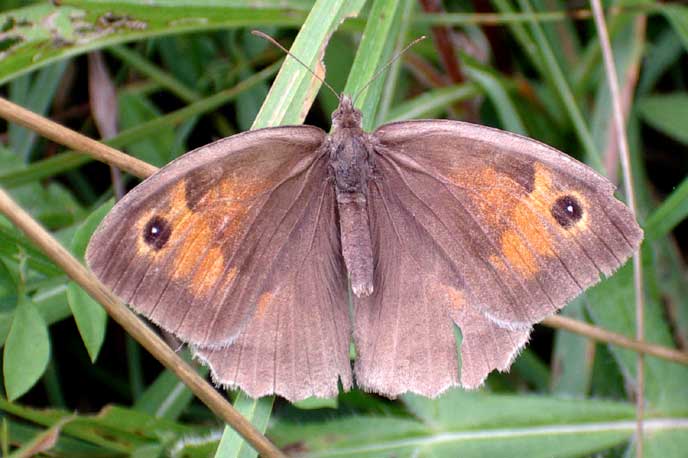 |
 |
 |
 |
|
|
|
|
|
 At
least thirty (quick estimate) Round-headed
Rampion plants were noted in flower on
the upper slopes north of the Reservoir. A single navy blue flower blossoms
on the top of a frail stalk.
At
least thirty (quick estimate) Round-headed
Rampion plants were noted in flower on
the upper slopes north of the Reservoir. A single navy blue flower blossoms
on the top of a frail stalk.
17
July 2005
Under
another warm afternoon with temperatures in excess of 26°
C, the count of Chalkhill
Blues on Mill Hill was 45, with 33 on
the lower slopes and 12 venturing above the ridge. Whitethroats
(or Lesser Whitethroats) were the one of the
small birds in the bushes.
Butterfly
List of the Day
12
July 2005
 On
the lower slopes of Mill Hill, the fresh
male Chalkhill Blue Butterflies
were out and I counted twenty of them over an area of 400 metres, but this
is just the beginning of them. Other butterflies
were prevalent, both Gatekeepers
and Meadow Browns
numbered over thirty and Small/Essex Skippers
(15+), Marbled Whites (15) and Green-veined
Whites were frequent on Mill Hill. There
was two Commas,
two Red Admirals,
and at least one Large White
on a day when I visited the lower slopes only, returning via the ridge.
On
the lower slopes of Mill Hill, the fresh
male Chalkhill Blue Butterflies
were out and I counted twenty of them over an area of 400 metres, but this
is just the beginning of them. Other butterflies
were prevalent, both Gatekeepers
and Meadow Browns
numbered over thirty and Small/Essex Skippers
(15+), Marbled Whites (15) and Green-veined
Whites were frequent on Mill Hill. There
was two Commas,
two Red Admirals,
and at least one Large White
on a day when I visited the lower slopes only, returning via the ridge.
Butterfly
List of the Day
The
Cotton
Thistle was beginning to flower in the
pasture to the east of Mill Hill.
8 July
2005
Fifteen
sleek Swifts
flew low level over Mill Hill, moving in a westerly direction.
Six-spot
Burnet Moths were emerging on the top
of Mill Hill where a small patch of Meadow
Cranesbill showed amongst the long grass where
it was nearly getting swamped by other vegetation.
 |
 |
 |
 |
Two
blue butterflies emerged on the lower slopes
of Mill Hill but they flew away much too quickly to be sure of their identity.
They were probably Chalkhill Blue Butterflies.
Both
Gatekeeper
and Meadow Brown Butterflies
were very frequently seen. There were 16 Marbled
Whites, 13 on Mill Hill (including 5 from
the lower slopes).
Shoreham
Bank 2005
Butterfly
List for the Day
3
July 2005
A
magnificent dragonfly settled on a pine tree
on the southern edge of the copse on the
top of Mill Hill. It was a female Southern
Hawker looking
very fresh and dangerous to other insects. My impression was that this
was possibly a different dragonfly species to the one seen on 1
July because it was not quite so active
on its patrols and this one appeared slightly smaller with less of a green
thorax. However, these differences could be explained by my failure to
get a good look at the first one.
 |
 |
Migrant
Hawker
This
dragonfly was well camouflaged two and half metres up in a pine tree
Adur
Dragonflies
Adur
Dragonfly Flight Times
Butterfly
List for the Day
24
June 2005
A
single Kidney Vetch
flower was recorded for the first time on Mill Hill in the Triangle
area. Other plants noted for the first time this year were Restharrow
in the area north of the upper car park, where a distinctive
snail (a tower-like pulmonate mollusc) was
feeding on Yellow Rattle.
This tower-like snail is probably Cochlicella
acuta. This is reported as a coastal
species only.
More
Information on the Snail
Field
Scabious was beginning to flower in the Triangle,
with expanses of Perforate St. John's Wort
where the Dogwood had been cleared, and Self-heal
in the Hawthorn scrub in the north-west, and Greater
Knapweed on the upper part where the grass
was longer and thicker.
 |
 |
 |
 |
Two
Large
Skippers were confirmed from the plateau
area with long grasses and Bird's Foot Trefoil
south of the upper car park.
Butterfly
List for the Day
Meadow Cranesbill which was so prevalent this time last year was not on show amongst the long grass to the north of the car park. This area was full of long heavy grass.
19
June 2005
With
a temperature at 27.1 ºC (warmest day
of the year so far going up to 27.1 ºC later), it
was not conducive to anything more than a casual stroll on the middle and
upper slopes. I noted some of the wild plants I could put a name to including
Bird's
Foot Trefoil, a small remaining patch of Horseshoe
Vetch in the Triangle,
over a hundred Dropwort
flowers on the upper plateau south of the car park (the same area that
the Horseshoe Vetch flowered in three weeks earlier), Agrimony,
Wild
Mignonette, the diminutive Eyebright,
Fairy Flax, Milkwort and
Common
Mouse-ear.
A small yellow flowered plant was
also commonly observed possibly Black Medick
or Hop Trefoil?
There
was Roe Deer
amongst the long grass in the meadow below (west of) Mill Hill.
Butterfly
List
18
June 2005
The
flowering Horseshoe Vetch
had completely disappeared although a solitary flower was noted on the
lower
slopes. Yellow Wort
flowers were closed in the heat of the afternoon.
The
small flowers of Fairy Flax
were noted in small clumps. Musk Thistles
were
just beginning to flower. Male Adonis Blue
Butterflies were counted at 16 on the
lower slopes only (only the upper slopes along the rim of the ridge were
visited).
Butterfly
List
Adur
Thistles
9 June
2005
In
the sunshine I visited the upper slopes only that I avoided two days ago,
and I found I needed a reappraisal of the flora. On the upper plateau south
of the car park the Horseshoe Vetch was
a larger component of the herbs and grasses that I first anticipated and
this was apparent as it was still at least half in flower, whereas on the
lower
slopes it had almost faded to nothingness and could not be seen at
a distance. The leaf flora south of the car park seemed to include a large
amount of Bird's Foot Trefoil,
but hardly any seemed to be in flower. Most of the other yellow were Bulbous
Buttercups, with Milkwort
in flower, Dropwort
beginning, Red Clover, Common
Mouse-ear and the small white flowers of Fairy
Flax. The variety of long grasses were noted
but not identified yet. Brome is almost certainly important in this area.
Butterflies
fluttering over this exposed area included about three Adonis
Blues, the same number of Common
Blues and at least five Small
Heaths.
 |
 |
 |
 |
The image on the far right is a plant over a metre in height, the Cotton Thistle, Onopordon acanthium, in the cattle pasture to the east of Mill Hill. This is a naturalised alien plant.
Adur ThistlesNorth of the car park the flora of herbs and grasses is much denser and altogether different with Horseshoe Vetch absent. I did not make a note of the flowering plants, although it did include Yellow Rattle on which a male Common Blue Butterfly landed and a few taller Bird's Foot Trefoil. There were at least three of these blues, but this was less than would be expected after a major emergence. There was one Adonis Blue seen over the taller herbs and grasses, and I was surprised by a sparring pair of Grizzled Skippers.
There
was a Speckled
Wood Butterfly in the copse
at the top of the Mill Hill.
In
the Triangle area of the middle slopes, Eyebrightwas
beginning to flower amongst the fading Horseshoe
Vetch and some Bird's
Foot Trefoil.
At
the top of the Pixie Path to Mill Hill, a
Small
White Butterfly fluttered over by the
bridge. In the small clear long grassy area of the south-west of the Mill
Hill Cutting (road bank by Chanctonbury Drive) a solitary Small
Blue Butterfly appeared after a wait of
under a minute.
Adur
Butterfly & Large Moth List 2005
7 June
2005
On
a sunny day after a week of clouds, I did not visit the upper slopes although
a handful of Adonis Blue Butterflies
were seen above the ridge north of the Reservoir with a male and female
Common
Blue
Butterfly.
Musk
Thistle was beginning to flower by the
Reservoir.
A
green Common Lizard was seen on the Pixie
Path and a Small Blue Butterfly
in the Mill Hill Cutting (next to the top
of Chanctonbury Drive).
Report
from the Lower Slopes
27
May 2005
On
the top slopes it is Horseshoe Vetch*
showing yellow in the sunshine under a bright blue sky and an
air temperature of 25.2 ºC.
(*
This area of an acre south of the car park also contains Bird's Foot Trefoil
not flowering yet.) On the
lower
slopes of six acres, Horseshoe Vetch
is still in superabundance, covering almost the whole area.
There
were no butterflies seen here though. The
butterflies were reserved for the lower slopes
where they were nearly a hundred and a handful on the middle slopes above
the ridge.
Adonis
Blues were the most frequent butterflies
with a count of 66 including 9 female and all bar one in a 1.2 acre section
on the lower slopes. They were accompanied by 20+
Small
Heaths on a luxurious carpet of Horseshoe
Vetch exceeding the spread of five days previously.
Just the one Dingy Skipper
was seen.
There
were at least four Holly Blue Butterflies
mating and chasing each other in the Hawthorn edge next to the road on
the east side just north of the bridge over the A27.
Butterfly
& Moth Report
Just inside the copse in the north-west corner (edge of the lower slopes) a blue damselfly made a too fleeting appearance to be sure of its identity.
22
May 2005
The
Kestrel
and Crow were
flying together over the slopes of Mill Hill, but I do not what bird was
mobbing which one?
On
the
lower slopes
the Horseshoe Vetch
was at its peak or slightly past it. I recorded 11 male Adonis
Blues and one female
in a 15 minute sojourn.
Adur
Butterfly & Large Moth List 2005
18
May 2005
One
of the Whitethroats
(small bird) was in a bush on the plateau part of Mill Hill south of the
Reservoir. Horseshoe Vetch
was showing in small patches, sometimes amongst long grass, between the
top car park and the Reservoir. Hound's
Tongue was prevalent near the rabbit warren
amongst the scrub at the top of the slopes near (north of) the Reservoir.
15
May 2005
A
Kestrel
and Crow
simultaneously mobbed a Stoat
on the Horseshoe Vetch
covered slopes of Mill
Hill.* Later
in the afternoon, a Stoat
was seen slinking over the short grass and herbs and making a quick bolt
down a rabbit burrow just
below the ridge. The Stoat
was out in the open for about two seconds.
In
the field below (west of) Mill Hill a young
Roe Deer calf was suckling from her mother
out in the meadow.*
 |
 |
 |
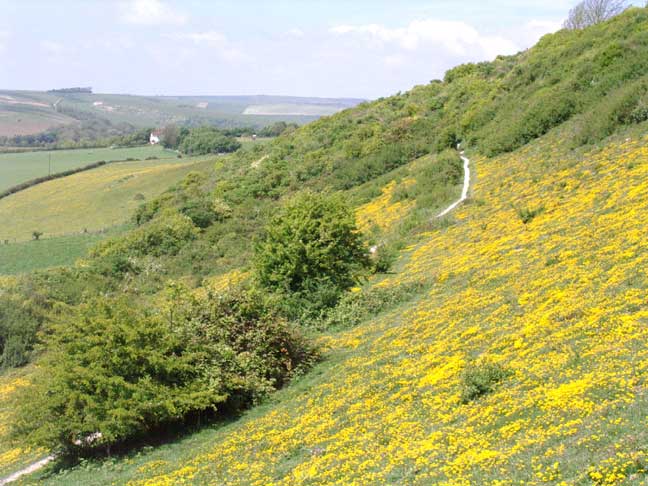 |
Adonis
Blue Butterfly
amongst
the Horseshoe Vetch
Photograph
by Katherine Hamblett (aged 10½ years)
 After
buffeting by the gales and strong breezes during the last week, the sun
came out and the butterflies, skippers and
moths
were now common (just over 100; about 60 on Mill Hill). On the lower slopes
of Mill Hill, the first four male
Adonis
Blue Butterflies of the year fluttered
around the Horseshoe Vetch
(which was at about 85% of its maximum luxuriance). The Wall
Brown Butterflies fluttered from the lower
slopes on to and above the ridge on to the shallower slopes and higher
vegetation including grasses (grow long later in summer).
After
buffeting by the gales and strong breezes during the last week, the sun
came out and the butterflies, skippers and
moths
were now common (just over 100; about 60 on Mill Hill). On the lower slopes
of Mill Hill, the first four male
Adonis
Blue Butterflies of the year fluttered
around the Horseshoe Vetch
(which was at about 85% of its maximum luxuriance). The Wall
Brown Butterflies fluttered from the lower
slopes on to and above the ridge on to the shallower slopes and higher
vegetation including grasses (grow long later in summer).
Thirteen
species of butterfly and skipper were seen in an hour and a half.
Butterfly
Report
Adur
Butterflies: First Dates
Adur
Butterfly & Large Moth List 2005
| The lower slopes were so dominated by the Horseshoe Vetch that other plants could be overlooked. Of particular note were a handful of Hound's Tongue, Cynoglossum officinale, (only the leaves have been recorded before) with most of the plants noted on the steep slopes just below the ridge. |  |
 |
6 May
2005
Lawrie
Keen drew my attention to the call of a Nightingale
that appeared to come from the fringe of the incursing woodland on the
southern slopes of Mill Hill (NE of the Waterworks House).
The small moth 2470 Small Purple-barred Moth Phytometra viridaria was recorded for the first time on the lower slopes of Mill Hill, although it has been seen before.
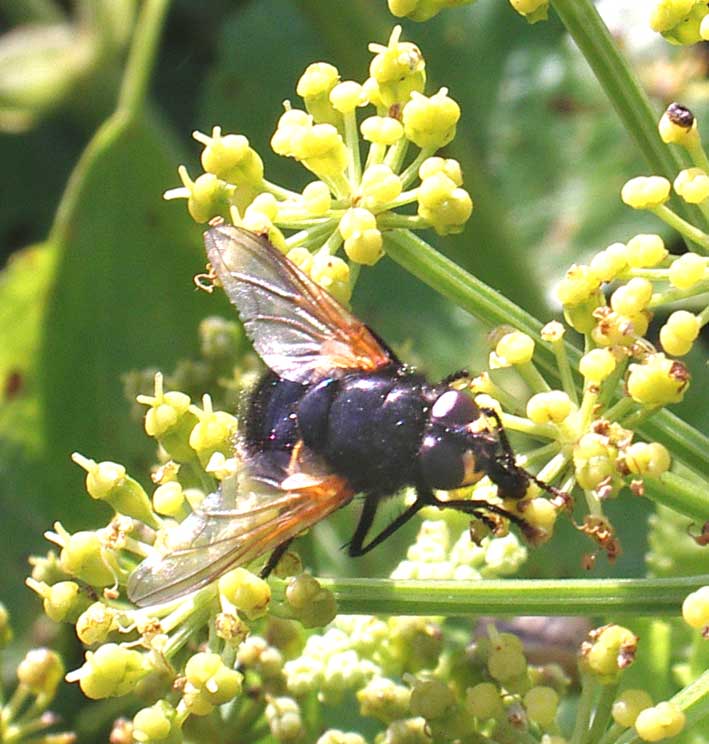 |
 |
 |
 |
The common Alexanders, Smyrnium olustratum, on the southern part of Mill Hill attracted hundreds of flies, including hoverflies. This enlarged picture is the hoverfly Leucozona lucorum. There has been an explosion of this species in Holland and Belgium this year. This pretty little hoverfly is widespread and common in England. (It is not included in the Collins Guide to British Insects by Michael Chinery.)
A Crane-fly was seen as well. (Originally identified as Nephrotoma appendiculata but now thought to be wrong.)
1
May 2005
As
the familiar Kestrel
performed flying over the lower
slopes, the afternoon failed to produce a possible glut of butterflies.
Moths
were common (well over a hundred) but they were mostly small ones. The
first Cinnabar Moth
of the year was seen on the Shoreham Bank.
Two
Common Partridges
were disturbed on the lower slopes of Mill Hill. I actually got quite close
(15 metres) them before they flew off towards the Adur
Levels and Spring Dyke. This was
the first time I had seen them on Mill Hill.
After
the rain in the last week, two species of mushroom
emerged on the upper slopes.
The first two Grizzled Skippers were seen on the first step down to the Shoreham Bank from the southern part of the upper slopes. In a recently cleared area in the north-west of Mill Hill, two male Orange Tip Butterflies fluttered by, only pausing to nectar on the common Ground Ivy for less than a second. The white butterflies were two Small Whites. An Andrena bee was noted on a Dandelion in the copse at the top of Mill Hill.
 Butterfly
and Moth Report from the Shoreham Bank
Butterfly
and Moth Report from the Shoreham Bank
Adur
Butterfly and Larger Moth List 2005
Shoreham
Fungi
29
April 2005
The
bright red of a Peacock Butterfly
was the first one on the lower slopes
of Mill Hill and then I was surprised by a flash of orange and I was able
to confirm a Small Heath Butterfly
and this was the same species as seen two days previously. Almost simultaneously,
I also disturbed a Dingy Skipper. I
had a wait between five and ten minutes for a single Grizzled
Skipper to appear at the northern end
of the lower slopes.
Full
Report from the Shoreham Bank
 The
black flies (with dangly bits) commonly seen at this time of the year are
St.
Mark's Flies,
Bibio
marci.
The
black flies (with dangly bits) commonly seen at this time of the year are
St.
Mark's Flies,
Bibio
marci.
27
April 2005
It
was blowing a Force 4 so it was Moderately Breezy
on the top of the hill. Immediately, I descended from the steps on to the
green herbland, a flutter of orange was two days later confirmed as the
first Small Heath Butterfly
of the year. Other butterflies were to be
found on the lower slopes: Grizzled
Skipper 11+,
Peacock
and
a Comma,
and in the scrub to the north-west, another Peacock,
and in the copse at the summit, a surprise Red
Admiral, old but not battered, and a male
Green-veined White; six species in total.
Full
Report from the Shoreham Bank
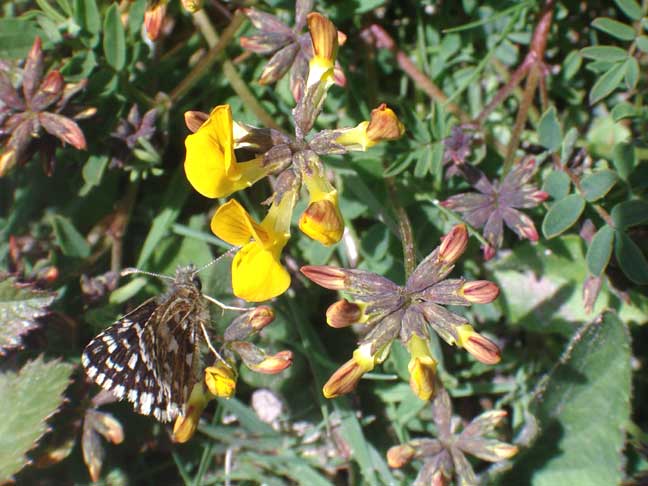 |
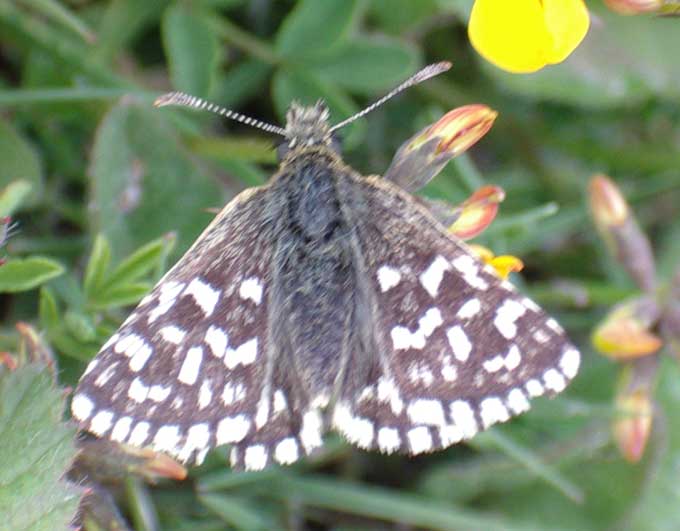 |
 |
 |
I noticed that the Hawthorn was spreading with small shrubs just south of the reservoir, including the steep slopes near the steps.
Adur
Butterfly Flight Times
Adur
Butterflies: First Dates
National
Butterflies: First Dates
Small
Insects of Mill Hill
19
April 2005
A
clearly seen Yellowhammer
flew from the lower slopes to the woodland
at the southern end where perched on the top of a small tree and sang.
The
small fluttering of brown was my first record of the small day-flying moth
Pyrausta
nigrata of the year on the lower
slopes of Mill Hill. Unless the moth settles it is easy to confuse
this species with the Grizzled Skipper
with at least one confirmed. These two species have identical browns and
cream colours but different patterns and occur at the same time on the
downs. The Grizzled Skipper is
larger. Altogether a total of at least six of either moths or skippers
were disturbed.
Adur
Butterfly and Larger Moth List 2005
 15
April 2005
15
April 2005
The
Kestrel
was hunting, hovering and then descending spectacularly near the Reservoir.
On
Mill
Hill and its approaches,
Sweet
Violets were fading and Dog
Violets were appearing.
There
was one Grizzled Skipper at
the northern end of the lower slopes,
and a Peacock Butterfly
was just under the ridge near the rabbit warren. A Green-veined
White was seen on the southern part of
Mill
Hill and this was the first of the year.
Adur
Violets
10
April 2005
 I
was greeted by a male Kestrel making
a ground strike on the upper slopes just south of the reservoir.
I
was greeted by a male Kestrel making
a ground strike on the upper slopes just south of the reservoir.
The
first, and only one, Grizzled Skipper (Butterfly)
of the year landed on the lower slopes
of Mill Hill for just a few seconds before it flew rapidly over the scrub
and out of view. This is the first national
record this year.
Other
butterflies
for the day included one a handful of both Peacock
Butterflies (Mill Hill and the A27
road
embankment a the top [north] of the Dovecote Estate, Shoreham), Small
Tortoiseshell Butterflies (Mill Hill and
the A27
road
embankment),
and
one Holly Blue (top
of Chanctonbury Drive, near [SE of) Mill Hill).
Adur
Butterflies
Adur
Butterfly List 2005
Adur
Butterfly Flight Times
Adur
Butterflies: First Dates
National
Butterflies: First Dates
Butterfly
Conservation Society
The
first dozen Dog Violets
were in flower on the Pixie Path to Mill
Hill, but on the lower slopes of
Mill
Hill the Sweet Violet
was still the dominant flower with tens of thousands including white specimens
forming a carpet of violet
in places. No Dog Violets
were identified (yet this year) on Mill Hill. Violets
were absent from the grazing areas in the adjoining field to the north
west of Mill Hill Nature Reserve (south of
Erringham Hill, south-east and up from Old Erringham Farm).
Adur
Violets
I saw my first hirundine of the year for a fraction of a second swooping over Erringham Hill. I think it was a Swallow.
3 April
2005
 |
 |
The
Sweet
Violets over all of the slopes and amongst
the scrub of Mill Hill numbered tens of thousands, mostly violet in colour,
but also white ones. In the grass the leaves were small but they were larger
in sheltered positions under the Hawthorn.
 1
April 2005
1
April 2005
There
were even more Sweet Violets
over the grass on the top of the hill, in the cleared scrub areas and under
the scrub in shelter. In the open the leaves were absent (could not be
discerned easily) or small and definitely without hairs. In the shade the
leaves were larger. A few white bunches occurred as well. Individually,
I could detect no scent from these violets.
Adur
Violets
No
butterflies
were seen in the weak sunshine of the late afternoon. A
Skylark
was singing. A Rook landed
on the empty pasture to the east of Mill Hill south. Cattle were grazing
on the stubble of Erringham Hill.
25
March 2005
 There
were thousands of Sweet Violets
growing on the
slopes of Mill Hill. A single Small Tortoiseshell
Butterfly visited
one of them for a second on the lower slopes.
It was characteristic of these violets on the lower slopes that the leaves
were diminutive, almost invisible and hard to discover. When just one was
discovered, they lacked the hairs of the Hairy
Violets. Almost all the flowers were the same
shade of violet without any markings or patterns found in Dog
Violets. Collectively, these violets
may have produced a faint perfume.
There
were thousands of Sweet Violets
growing on the
slopes of Mill Hill. A single Small Tortoiseshell
Butterfly visited
one of them for a second on the lower slopes.
It was characteristic of these violets on the lower slopes that the leaves
were diminutive, almost invisible and hard to discover. When just one was
discovered, they lacked the hairs of the Hairy
Violets. Almost all the flowers were the same
shade of violet without any markings or patterns found in Dog
Violets. Collectively, these violets
may have produced a faint perfume.
Adur
Violets
Honey
Fungus was spotted on a few stumps of
cleared scrub and the lichen
(shown
in the photograph on the right) growing in the fork of a Hawthorn twig.
There were a dozen or more Buff-tailed
Bumblebee Queens buzzing about and entering
holes (nests).
A
Green
Woodpecker was resting in the short grass under the ridge of Mill Hill,
before flying with its characteristic dipping flight over towards the wooded
area near the Waterworks House.
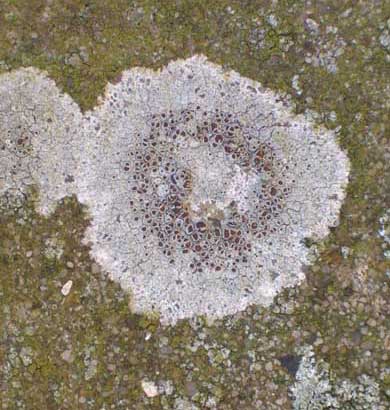 18
March 2005
18
March 2005
A
Skylark
was fluttering and singing in the air over the empty grazing field to the
east of the southern part of Mill Hill.
16
March 2005
Mill
Hill is bathed in sunshine as the air temperature
attains 14.6 ºC.
A
Small
Tortoiseshell Butterfly was disturbed
basking in the midday sun on the Pixie
Footpath adjacent to the horse's fields on the way to Mill
Hill, when I was quick enough to make a positive identification.
There
was still standing water in the muddy bits next to the southern car park.
Sweet
Violets were in flower at the top of the
steep bank and one or two appeared to be on the lower slopes as well.
Adur
Violets
 |
 |
 |
|
|
|
|
Over a thousand gulls, mostly Black-headed Gulls and Common Gulls followed the plough on the field below (west) Mill Hill on the Adur Levels. There was evidence of conservation work with the removal of scrub including Privet on the lower and middle slopes, burning the wood on site, which is not best practice because it creates a high nutrition area. On the top slopes there had been some forage harvesting of grasses with mounds stashed up to rot, again producing areas of high nutrition. The Kestrel flew over as expected.
On
the lower slopes of Mill Hill, I was again
surprised by a bright yellow Brimstone
Butterfly being mobbed by a dark
brown butterfly or day-flying moth which was
not identified. Another Brimstone Butterfly
appeared and two of these large butterflies were in my field of view at
the same time. The third butterfly of the day was a Red
Admiral basking on the tarmac path in
the copse at the brow of Mill Hill.
Adur
Butterflies
Adur
Butterfly List 2005
Adur
Butterfly Flight Times
Adur
Butterfly: First Dates
13
March 2005
A
very confiding Firecrest
was seen at Mill Hill in the hedge to the right between bridge over the
A27 and Mill Hill. It had a ring, which appeared very shiny and new, on
it's right leg.
3
March 2005
No
sign of snow in Shoreham town but looking out
of my window, there was a thin layer of snow on the downs
above Shoreham. This snow was only on the high ground north of the A27
By-pass, and the pastures from Slonk Hill
westwards to Mill Hill were green.
27
February 2005
A
small brown bird flew out of, or more likely through a Hawthorn bush just
north of the southern car park and settled on the grass and muddy path.
It remained stationary long enough for me to extract my binoculars and
focus on the bird about ten metres away. I had the back view for a minute,
but it was not until it turned slightly that I could confirm the bird as
a Skylark.
On the ground, it is not nearly as attractive as when it is in the air.
However, its face is distinctive, before flurries of sleet blew in from
the east and obscured the view.
This
could conceivably be a migrant bird rather than a resident?
8
February 2005
There
were at least a couple of Rooks in
the churned up cattle pasture immediately to the east of Mill Hill.
Rooks
are not common near the urban area and only seen occasionally in winter.
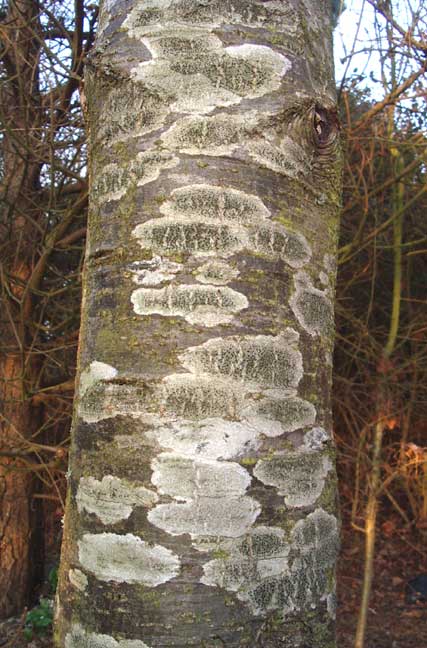 |
 |
 |
 |
With
very little of natural interest, I took a closer look at the lichens
on the trees and bushes of Mill Hill. The pictures above show the lichens
of most interest. The one with the miniature black tar-like globules in
the first three photographs were not seen before in Shoreham town, but
I may have overlooked them. They are probably a reasonably common species.
These lichens were photographed on Italian
Alder but were to be found on the Hawthorn
as well. The other lichens in the photograph on the far right are prevalent
species.
Adur
Lichens
On the path leading to Mill Hill, I noted and photographed a few lichens, mosses and other growths on wood. The photograph on the right shows the podentia of a Cladonia lichen.
LINK TO THE WILDLIFE REPORTS FOR AUTUMN - SUMMER 2004
LINK TO THE MILL HILL WILDLIFE REPORTS FOR WINTER & SPRING 2004
| Chalkhill
Blue (3000 +)
Adonis Blue (50 -100) Dingy Skipper (75) |
Small
Heath (250)
Wall Brown (12) Meadow Brown (300) |
Marbled White (50)
Gatekeeper (200) Speckled Wood (>50) Green-veined White (2+) |
Common
Blue (>3000+)
Small Blue (5) Brimstone (8) |
Small
Skipper (>50)
Large Skipper (10+) Grizzled Skipper (20) Brown Argus (>30) |
The other species may breed on Mill Hill, but there main breeding area will be adjoining fields or slightly further away. e.g. Small Blue (included above), Small Copper, Small Tortoiseshell, Green-veined White, Peacock, Ringlet, Small White, Large White, Comma, Holly Blue, Orange Tip. (=10)
The following are immigrants &/or hibernators: Red Admiral, Painted Lady, Clouded Yellow.
The following have not been positively identified (because of ID difficulties): Essex Skipper. This species is now included for a local field on the Adur Levels within 500 metres of Mill Hill.
(=30)
The
following may occur but it has not been positively identified (because
it is elusive and hard to spot): Green Hairstreak.
The next one is no longer
found on Mill Hill but were there in the recent (reduced drastically to
almost extinct by 1948 last record in 1968) past: Dark
Green Fritillary (Records of this butterfly
in 1857, 1938, and 1945 when it was common.)
The next one is no longer
found on Mill Hill but were there in the distant (1947) past: Grayling.
The next one has been recorded
near Mill Hill in the middle distance past: White-letter
Hairstreak
(=34)
The Silver-spotted Skipper does not appear to ever have occurred on Mill Hill
Rare
Vagrant:
A
Short-tailed Blue Butterfly, Cupio
argades, was recorded from Shoreham in 1956
Link
to the Mill Hill WILDLIFE REPORTS up to 2003
with
lots of Butterfly observations
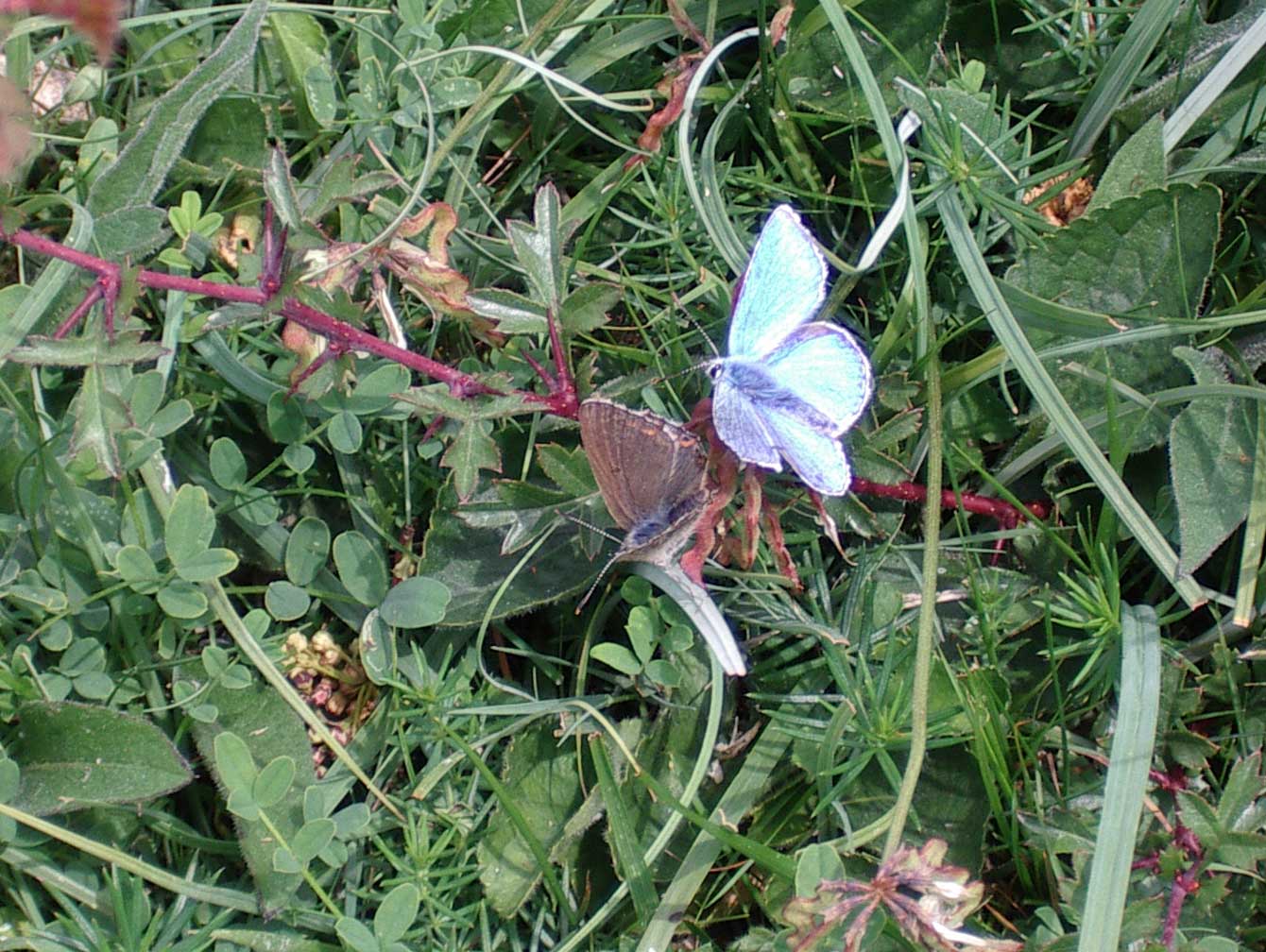 Lower
Slopes (with Butterfly Reports)
Lower
Slopes (with Butterfly Reports)
Mill Hill Nature Reserve (including map)
MultiMap Aerial Photograph of Mill Hill
Back
to Mill Hill
Triangle
Upper
Slopes
Middle
Slopes
Lower
Slopes
Grasses
of Mill Hill
Mill
Hill Copse
Aerial
Map
Lower
Adur Levels (MultiMap) including Lancing Clump and Mill Hill
Hippocrepis
comosa (Horseshoe Vetch)